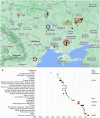North Pontic crossroads: Mobility in Ukraine from the Bronze Age to the early modern period
- PMID: 39772694
- PMCID: PMC11708899
- DOI: 10.1126/sciadv.adr0695
North Pontic crossroads: Mobility in Ukraine from the Bronze Age to the early modern period
Abstract
The North Pontic region, which encompasses present-day Ukraine, was a crossroads of migration, connecting the vast Eurasian Steppe with Central Europe. We generated shotgun-sequenced genomic data for 91 individuals dating from around 7000 BCE to 1800 CE to study migration and mobility history in the region, with a particular focus on historically attested migrating groups during the Iron Age and the medieval period. We infer a high degree of temporal heterogeneity in ancestry, with fluctuating genetic affinities to different present-day Eurasian groups. We also infer high heterogeneity in ancestry within geographically, culturally, and socially defined groups. Despite this, we find that ancestry components which are widespread in Eastern and Central Europe have been present in the Ukraine region since the Bronze Age. In short, our study reveals a diverse range of ancestries in the Ukraine region through time as a result of frequent movements, assimilation, and contacts.
Figures






Similar articles
-
A genomic history of the North Pontic Region from the Neolithic to the Bronze Age.Nature. 2025 Mar;639(8053):124-131. doi: 10.1038/s41586-024-08372-2. Epub 2025 Feb 5. Nature. 2025. PMID: 39910299 Free PMC article.
-
Ancient genomes suggest the eastern Pontic-Caspian steppe as the source of western Iron Age nomads.Sci Adv. 2018 Oct 3;4(10):eaat4457. doi: 10.1126/sciadv.aat4457. eCollection 2018 Oct. Sci Adv. 2018. PMID: 30417088 Free PMC article.
-
Ancient genomes reveal structural shifts after the arrival of Steppe-related ancestry in the Italian Peninsula.Curr Biol. 2021 Jun 21;31(12):2576-2591.e12. doi: 10.1016/j.cub.2021.04.022. Epub 2021 May 10. Curr Biol. 2021. PMID: 33974848
-
Genomes from Verteba cave suggest diversity within the Trypillians in Ukraine.Sci Rep. 2022 May 4;12(1):7242. doi: 10.1038/s41598-022-11117-8. Sci Rep. 2022. PMID: 35508651 Free PMC article.
-
Ancient X chromosomes reveal contrasting sex bias in Neolithic and Bronze Age Eurasian migrations.Proc Natl Acad Sci U S A. 2017 Mar 7;114(10):2657-2662. doi: 10.1073/pnas.1616392114. Epub 2017 Feb 21. Proc Natl Acad Sci U S A. 2017. PMID: 28223527 Free PMC article.
References
-
- Allentoft M. E., Sikora M., Sjögren K.-G., Rasmussen S., Rasmussen M., Stenderup J., Damgaard P. B., Schroeder H., Ahlström T., Vinner L., Malaspinas A.-S., Margaryan A., Higham T., Chivall D., Lynnerup N., Harvig L., Baron J., Della Casa P., Dąbrowski P., Duffy P. R., Ebel A. V., Epimakhov A., Frei K., Furmanek M., Gralak T., Gromov A., Gronkiewicz S., Grupe G., Hajdu T., Jarysz R., Khartanovich V., Khokhlov A., Kiss V., Kolář J., Kriiska A., Lasak I., Longhi C., McGlynn G., Merkevicius A., Merkyte I., Metspalu M., Mkrtchyan R., Moiseyev V., Paja L., Pálfi G., Pokutta D., Pospieszny Ł., Price T. D., Saag L., Sablin M., Shishlina N., Smrčka V., Soenov V. I., Szeverényi V., Tóth G., Trifanova S. V., Varul L., Vicze M., Yepiskoposyan L., Zhitenev V., Orlando L., Sicheritz-Pontén T., Brunak S., Nielsen R., Kristiansen K., Willerslev E., Population genomics of Bronze Age Eurasia. Nature 522, 167–172 (2015). - PubMed
-
- Haak W., Lazaridis I., Patterson N., Rohland N., Mallick S., Llamas B., Brandt G., Nordenfelt S., Harney E., Stewardson K., Fu Q., Mittnik A., Bánffy E., Economou C., Francken M., Friederich S., Pena R. G., Hallgren F., Khartanovich V., Khokhlov A., Kunst M., Kuznetsov P., Meller H., Mochalov O., Moiseyev V., Nicklisch N., Pichler S. L., Risch R., Rojo Guerra M. A., Roth C., Szécsényi-Nagy A., Wahl J., Meyer M., Krause J., Brown D., Anthony D., Cooper A., Alt K. W., Reich D., Massive migration from the steppe was a source for Indo-European languages in Europe. Nature 522, 207–211 (2015). - PMC - PubMed
-
- Preda-Bălănică B., Frînculeasa A., Heyd V., The Yamnaya Impact North of the Lower Danube: A tale of newcomers and locals. Bulletin de la Société préhistorique française 117, 85–101 (2020).
-
- Matuzevičiūtė G. M., Telizhenko S., The first farmers of Ukraine: An archaeobotanical investigation and AMS dating of wheat grains from the Ratniv-2 site. Archaeologia Lituana 17, 100–111 (2017).
Publication types
MeSH terms
LinkOut - more resources
Full Text Sources

